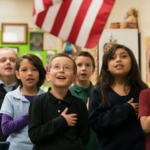But What About The Second Half?
By Marilyn Geewax
NPR, July 2, 2015 — Maybe it seems like just yesterday that you were storing away your holiday decorations.
Maybe it actually was yesterday because life gets busy and tasks get put off, and before you know it, half the year is over and you’re scrambling to catch up.
So in case you have been too busy to pay close attention, here’s what we now know about the just-ended half of this year’s economy:
On Friday, the Labor Department provided another reasonably upbeat monthly jobs report — good enough to make 2015 a winner so far for workers.
In June, employers added 223,000 jobs, and it was the 64th straight month of private-sector job growth — the longest streak on record. And the unemployment rate fell by two-tenths of a point to 5.3 percent, the lowest level since April 2008. In January, unemployment was 5.7 percent, so the trend is encouraging. And the average monthly gain in payrolls for the year’s first half was 208,000 — not a bad pace for a 6-year-old recovery.
But the June report also underscored problems that have plagued workers in 2015. For one thing, the pace of job creation cooled compared with the second half of 2014. In the back half of last year, monthly job growth averaged 281,000.
Here’s another disappointment: In June, average hourly wages did not go up — not by even one penny.
Betsey Stevenson, a member of the White House Council of Council of Economic Advisers, shared her reaction with NPR’s Scott Horsley: “Obviously, zero is a disappointing number.”
To be fair, wages are up 2 percent from this time last year, but still, June’s flat line suggests raises are losing momentum.
And there’s this, too: The labor-force participation rate slipped to 62.6 percent, down from 62.9 percent. That marked the lowest level since 1977 — and may mean discouraged Americans aren’t even trying to find jobs.
So, on balance, the labor market is doing OK, but it could be a lot better.
As for the second half of 2015, economists are somewhat optimistic, expecting moderate economic growth of 2.5 percent. Among the positive factors: higher consumer spending and confidence, tied to cheaper energy.
“The national average gasoline price likely peaked for this year in mid-June at $2.91 per gallon and the price is $2.88 per gallon heading into the July 4 holiday weekend — much lower than $3.73 per gallon at last year’s July 4 weekend,” PNC chief economist Stu Hoffman said in his written outlook. By Christmas, he expects gas to be down to $2.40 a gallon — helping give consumers a spending boost even without raises.
Even though the outlook is generally upbeat, there are risks looming in the second half of the year. For example, the debt crisis in Greece could worsen and deeply rattle financial markets. The Federal Reserve could start raising interest rates in September and touch off a bad market reaction among investors. Congress could allow a debt-ceiling problem to spiral into a crisis this fall.
But there are always dangers. On balance, the last line of Hoffman’s assessment probably best summed up the big picture:
“Happy July 4 holiday weekend. The U.S. economy has much to celebrate!”
www.npr.org/2015/07/02/419547599/it-s-half-time-for-2015-what-s-the-outlook-for-the-next-half










